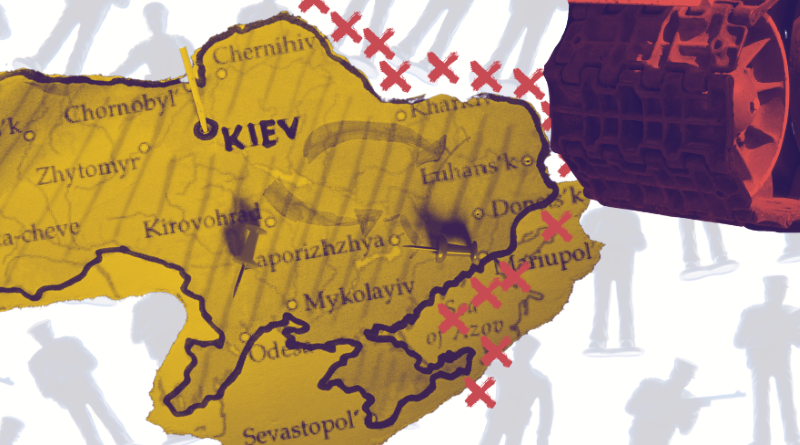Russian Military Build-up Next to Ukrainian Border: What Do We Know?
By Lisa May, Alumna of The Fletcher School at Tufts University
In late March, news about major Russian military build-up near Ukrainian border began to emerge in Ukraianian media space. Ukrainian Foreign Minister Dmytro Kuleba later confirmed that Russia has been amassing its troops along the eastern border and in Crimea. Multiple videos on social media show Russian armored convoys moving towards the Russian-Ukrainian border. Ukrainian officials estimate that Russian forces in the Voronezh region, which is located over 100 miles east from Ukrainian border, number 40,000. Additional 40,000 troops are stationed in Crimea, according to Ukrainian sources.
In addition to Russia amassing its forces near Ukraine, there has been a notable escalation of the conflict in the east of Ukraine, whereby on March 26th, four Ukrainian soldiers were killed, and another seriously wounded. According to European monitors, artillery fire has lately been occurring more and more often. On March 30th, Ukrainian Verkhovna Rada released a statement calling on Russia to stop the fire and urging it to strictly adhere to a ceasefire agreed upon in July 2020. The officials also noted that there has been a significant increase in shelling and armed provocations by the Russian armed forces. At the same time, the Kremlin spokesperson Dmitry Peskov also acknowledged recent escalation. When asked about the state of negotiations between Russia and Ukraine, and the Normandy format particularly, he commented that progress has not been made in a while.
Image Source: The Guardian
Although Russia had carried out large military exercises close to Ukrainian border in the past, this year the size as well as broad composition of its military build-up have attracted international attention. The White House classified the ongoing Russian military build-up as the largest since 2014, and Pentagon Press Secretary John Kirby urged the Russian authorities to “tell the world what they’re doing, and with what forces, and what capabilities, and what their intentions are.” Secretary of State Antony Blinken said he was concerned about Russian actions and warned that Russian aggressive behavior will have consequences. President Joe Biden had a phone conversation with Ukrainian President Volodymyr Zelensky, whereby the U.S. leader “reaffirmed the United States’ unwavering support for Ukraine’s sovereignty and territorial integrity in the face of Russia’s ongoing aggression in the Donbas and Crimea.” NATO also condemned Russian military build-up near Ukrainian border and its violations of the July 2020 ceasefire.
When it comes to reasons for such massive military build-up, there are several plausible explanations. Domestically, Vladimir Putin faces parliamentary elections in September, and his approval rating has been slowly decreasing, along with that of his political party – the United Russia. It is possible that by staging a large-scale show of force, the Russian leader is trying to boost his rating. Somewhat related to the previous reason, Russian military build-up could be an effort to distract international community from Russia’s internal issues. For example, recently a petition calling for further demonstrations in support of Alexei Navalny has been signed by 360,000 people, and organizers hope to gather 500,000 signatures before taking to the streets again. Alternatively, Russia might simply be testing President Joe Biden and the new U.S. Administration to see how far American support for Ukraine would actually extend.
While Western governments try to guess what Russia’s intentions truly are, Moscow officials continue to downplay the issue. On April 13th, Russian Defense Minister Sergei Shoigu said the ongoing exercise was a response to efforts by the United States and its NATO allies to increase their presence near Russian borders, and that it would last for another two weeks. Dmitry Peskov earlier commented that Russian troops are stationed on the Russian territory, in the locations the country deems strategically important and appropriate, and that they will remain there for as long as the country’s leadership considers necessary. He also mentioned that the Kremlin fears that Ukraine is on a brink of civil war, which in turn threatens Russian national security. Dmitry Kozak, Russia’s chief negotiator in relations with Ukraine, warned that Ukraine’s attempt to regain control of its eastern breakaway regions by force would mark “the beginning of the end of Ukraine.” The Russian official made this remark when commenting on President Zelensky’s statement that Ukraine’s accession to NATO would be the only way to save Ukraine and resolve the conflict in Donbas. Kozak also said that Kyiv is possibly preparing to ethnically cleanse Russian speakers in the Donbas, and that it was possible that Russia would have to protect the people. In his remarks he drew a rather far-fetched comparison between current events in Ukraine to a 1995 massacre in Srebrenica, when 8,000 Bosnian Muslims were killed by Serbian forces.
This piece is republished from the ERA Institute.


